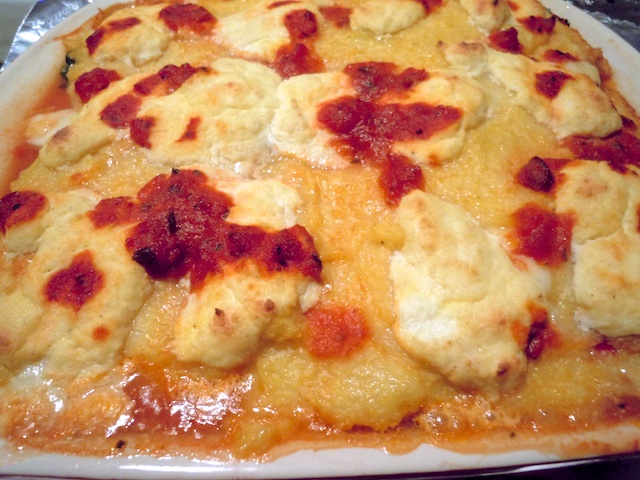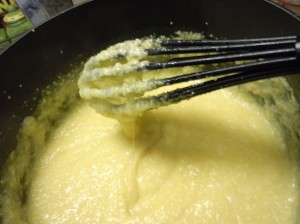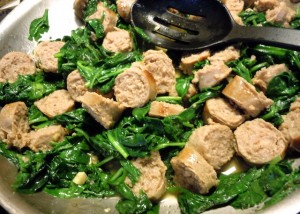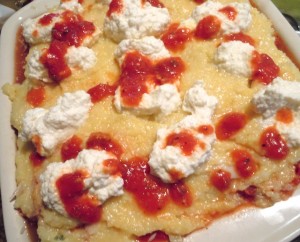 [M]y recent foray into ground corn (see previous blog about cornbread) got me excited about another version of the creature — polenta, a delicious interpretation that, cooked up, lends its creamy self to all manner of delicacies. Most recently, I found myself yet again floating toward the television, watching a celebrity chef make an intoxicating looking dish he called Polenta Lasagne, ladling thick layers of the buttery, hearty porridge with layers of cooked sausage and spinach, marinara sauce, mozzarella, roasted bell peppers and ricotta. I nearly fell to my knees watching this heavenly concurrence of deliciousness. I vowed to put one together myself, despite the arm-length list of ingredients I would need to procure.
[M]y recent foray into ground corn (see previous blog about cornbread) got me excited about another version of the creature — polenta, a delicious interpretation that, cooked up, lends its creamy self to all manner of delicacies. Most recently, I found myself yet again floating toward the television, watching a celebrity chef make an intoxicating looking dish he called Polenta Lasagne, ladling thick layers of the buttery, hearty porridge with layers of cooked sausage and spinach, marinara sauce, mozzarella, roasted bell peppers and ricotta. I nearly fell to my knees watching this heavenly concurrence of deliciousness. I vowed to put one together myself, despite the arm-length list of ingredients I would need to procure.
Excited, I told my friend, Al Dente Floyd, about the recipe. Al Dente has Italian in his bloodline and loves food. I thought he would share my enthusiasm.
“That’s just wrong,” ADF dismissed. ADF has some haughty tendencies that make him both irritating and appealing.
How is it wrong? I was perplexed.
“Lasagne is lasagne, and so on. No fusion,” he replied.
 Apparently, to some, a lasagne cannot be labeled so without those broad noodles. I offered up the fact that recipes of lasagne were often created with layers of zucchini or eggplant serving as the “pasta.”
Apparently, to some, a lasagne cannot be labeled so without those broad noodles. I offered up the fact that recipes of lasagne were often created with layers of zucchini or eggplant serving as the “pasta.”
“That’s Parmesan,” Al sniffed. Whatever. I bowed out of the disagreement. What I’ve come to learn about Floyd is that he does not acquiesce, and is rarely apologetic. This does not matter to A Woman Sconed. She is rarely wrong, knows it, but takes the high road, letting others think they have won. Hee.
What would you call this dish if it were not lasagne? Polenta Casserole? Never.
Versatile polenta cooks up to a creamy porridge (sometimes used as a side dish in lieu of mashed potatoes), firms up upon cooling and can be cut or sliced and then fried, baked or grilled. It can be purchased, pre-cooked, in tubes and then incorporated as a base for an appetizer or a main dish, like LASAGNE.
 I cooked my polenta, never having done so before. In an easy 20 minutes, with recurring whisking, I had a pot of polenta, smooth and buttery smelling.
I cooked my polenta, never having done so before. In an easy 20 minutes, with recurring whisking, I had a pot of polenta, smooth and buttery smelling.
This recipe incorporates a host of other things, all layered between levels of polenta — cooked sausages and sautéed spinach, marinara sauce, sliced mozzarella cheese, parmesan and ricotta cheeses and roasted red pepper. It makes the mind go dim and salivary glands take over just a-thinkin about it.
 I could barely contain everything in my baking dish, but that did not matter to me. I believed this was supposed to be a big, decadent, messy endeavor and I was behind that all the way!
I could barely contain everything in my baking dish, but that did not matter to me. I believed this was supposed to be a big, decadent, messy endeavor and I was behind that all the way!
It baked up beautifully. I had wondered if the polenta would give amid the weightiness of the fillings, but it held as sturdy and strong as any broad piece of pasta. It was delicious — juicy and hearty, with sausage meeting marinara and crunchy peppers, meldings of cheeses. Oh, boy! It was worth every step. The leftovers were even better, and I found the polenta firmed up even better for the second-day serving.
 I’ll honor my friend and his heritage and his traditionalist views. We all have our convictions. But, to me, Al Dente’s argument is parboiled. This recipe was created by an Italian, with an Italian corn porridge as its base. It was as lasagne as any lasagne I had eaten. Call it any name you like, but if you try it, you will likely call it “good”!
I’ll honor my friend and his heritage and his traditionalist views. We all have our convictions. But, to me, Al Dente’s argument is parboiled. This recipe was created by an Italian, with an Italian corn porridge as its base. It was as lasagne as any lasagne I had eaten. Call it any name you like, but if you try it, you will likely call it “good”!
Polenta Lasagne
Recipe from “Easy Entertaining with Michael Chiarello” (www.foodtv.com)
Ingredients
For the spinach/sausage:
2 tablespoons extra-virgin olive oil
4 cloves chopped garlic
3 (10-ounce) bags spinach, washed, any large stems removed
Gray salt and freshly ground black pepper
2 pound Italian sausage links, cooked and sliced 1/8-inch thick
For the ricotta mixture:
2 cups fresh ricotta cheese
2 egg yolks
1/4 teaspoon freshly grated nutmeg
•
For the polenta:
15 cups water
2 tablespoon sea salt, preferably gray salt
3 cups fine grind polenta
2 cups grated Parmesan
4 teaspoons roasted garlic oil, or extra-virgin olive oil
•
To assemble:
4 cups prepared marinara sauce
Directions
Polenta
Spinach/sausage mixture
1 cup jarred roasted, peeled and seeded yellow pepper, cut into 1-inch squares
1 cup jarred roasted, peeled and seeded red pepper, cut into 1-inch squares
1/2 cup grated Parmesan
1 pound fresh mozzarella, thinly sliced
Ricotta mixture
For the spinach/sausage slices:
Heat the oil in a large skillet over high heat. Add the garlic and saute until lightly browned. Add half the spinach into the skillet. As soon as it wilts, add the remaining spinach. Season with salt and pepper and remove from heat. Add the sausage slices to marry the flavors together. Remove from heat.
For the ricotta mixture:
In a small bowl combine the ricotta, egg yolks, and nutmeg. Set aside.
For the polenta:
In a large saucepan, bring the water and salt to a boil. Gradually whisk in n the polenta and cook over low heat for about 20 to 30 minutes, stirring often, until the grains are soft. Stir in the Parmesan and olive oil.
To assemble:
Set aside 4 tablespoons of the marinara sauce for the top of the lasagna. In large casserole dish layer: 6 cups of polenta, 1/2 the spinach / sausage slices, 1/2 the peppers, 1/2 the marinara sauce, 1/2 the Parmesan, and 1/2 the mozzarella slices.
Repeat. Top with the remaining polenta (it may not cover the top completely). Distribute the ricotta mixture over the top in small dollops. Drizzle the reserved marinara on top. At this point the finished lasagna can be wrapped and refrigerated for up to a day.
Preheat the oven to 375 degrees F.
Place the pan on a cookie sheet (in case it bubbles over). Bake about 45 minutes to 1 hour, or until it is bubbling and hot throughout. Remove from the oven and allow it to rest for several minutes before serving.
Blogger’s Note: I made 1/2 this recipe and it filled a deep dish 9-inch casserole dish.